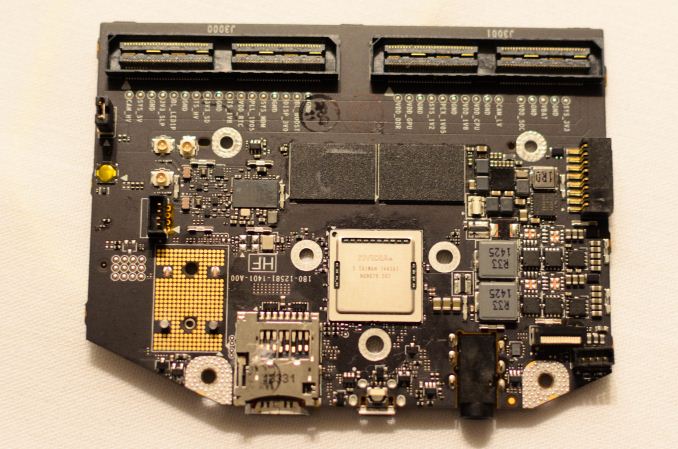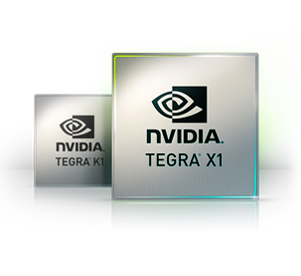NVIDIA Tegra X1 Preview & Architecture Analysis
by Joshua Ho & Ryan Smith on January 5, 2015 1:00 AM EST- Posted in
- SoCs
- Arm
- Project Denver
- Mobile
- 20nm
- GPUs
- Tablets
- NVIDIA
- Cortex A57
- Tegra X1
Final Words
With the Tegra X1, there have been a great deal of changes when compared to Tegra K1. We see a move from Cortex A15 to A57 on the main cluster, and a move from a single low power Cortex A15 to four Cortex A53s which is a significant departure from previous Tegra SoCs. However, the CPU design remains distinct from what we see in SoCs like the Exynos 5433, as NVIDIA uses a custom CPU interconnect and cluster migration instead of ARM’s CCI-400 and global task scheduling. Outside of these CPU changes, NVIDIA has done a great deal of work on the uncore, with a much faster ISP and support for new codecs at high resolution and frame rate, along with an improved memory interface and improved display output.
Outside of CPU, the GPU is a massive improvement with the move to Maxwell. The addition of double-speed FP16 support for the Tegra X1 helps to improve performance and power efficiency in applications that will utilize FP16, and in general the mobile-first focus on the architecture makes for a 2x improvement in performance per watt. While Tegra K1 set a new bar for mobile graphics for other SoC designers to target, Tegra X1 manages to raise the bar again in a big way. Given the standards support of Tegra X1, it wouldn’t be a far leap to see more extensive porting of games to a version of SHIELD Tablet with Tegra X1.
NVIDIA has also made automotive applications a huge focus in Tegra X1 in the form of DRIVE CX, a cockpit computing platform, and DRIVE PX, an autopilot platform. Given the level of integration and compute present in both DRIVE CX and PX, there seems to be a significant amount of value in NVIDIA’s solutions. However, it remains to be seen whether OEMs will widely adopt these solutions as car manufacturers can take multiple years to implement a new SoC. Compared to the 3-4 month adoption rate of an SoC in a phone or tablet, it's hard to pass any judgment on whether or not NVIDIA's automotive endeavors will be a success.
Overall, Tegra X1 represents a solid improvement over Tegra K1, and now that NVIDIA has shifted their GPU architectures to be targeted at mobile first, we’re seeing the benefits that come with such a strategy. It seems obvious that this would be a great SoC to put in a gaming tablet and a variety of other mobile devices, but it remains to be seen whether NVIDIA can get the design wins necessary to make this happen. Given that all of the high-end SoCs in the Android space will be shipping with A57 and A53 CPUs, the high-end SoC space will see significant competition once again.













194 Comments
View All Comments
Mayuyu - Monday, January 5, 2015 - link
Apple should start licensing Nvidia GPUs instead of Imagination GPUs for next generation iDevices.twotwotwo - Monday, January 5, 2015 - link
It might be hard (or impossible) for them to do that without breaking compatibility with existing iOS games written around the PowerVR's quirks.Krysto - Monday, January 5, 2015 - link
The OpenGL stuff shouldn't be "impossible". Even the texture compression. I think developers can deal with that. Where Apple really shot itself in the foot is with the launch of the Metal API, though. Now they're stuck with Imagination for at least a few more years until they make it more abstract to work with multiple GPU architectures and not so..."metal". Or they can wait for OpenGL NG to appear, which will probably take just as much time.techconc - Monday, January 5, 2015 - link
How exactly did Apple "shoot itself in the foot" with Metal. They have a solution right now for mobile apps that rivals what is possible on other platforms. All the major game engines have already migrated to Metal. nVidia can show these generic OpenGL benchmarks all they want, but in practice, graphic intensive apps on the A7 and A8 series chips are seeing far greater efficiency and performance improvements.OpenGL NG sounds great in concept, but it takes forever for a consortium like Khronos to develop new standards and just as long for them to eventually be adopted. This is years away from becoming a reality. Yet, Apple gets all of the benefits of that right now. From my perspective, this gives Apple a strong competitive advantage.
akdj - Sunday, January 11, 2015 - link
Well said techconcNot sure if you're in to development, SoC design or just a 'user', Krysto...but BOTH Apple's 'Metal' and language 'Swift' were/are HUGE leaps forward to 'cut' the peanut butter layer on the GPU that is Open GL ES ...so developers have 'direct' access to the 'metal' AKA GPU portion of the SoC. It's an amazing feat in 'software engineering' that helped a huge load on the 'hardware engineering' side of the house....specifically because of this!
I own a Note 4 for my business
I own a 6+ as a personal driver.
The former a quad core, 2.7x Ghz procs and the Adreno 420 and 3GB of 'shared' SoC RAM
The latter, a dual core, 1.5Ghz procs with IT's solution for graphics and 1GB of 'shared' SoC RAM
I love them both, different reasons BUT, Play Asphalt 8 on both. Then tell me 'more muscle, power, RAM, cores or core speed' are the reasons I'm playing a more fluent game on iOS vs android
I'm ambidextrous and enjoy using both. Same in the office or home environment. OS X is primary but I've always had a Windows box since the big 'switch' a decade ago
Point being, software is damn near, and sometimes MORE important than hardware to the end user's experience. No one outside of us dorks, geeks, and pocket protector wearing Homers has a clue what FitFat, latency, core clock speed, or hell....cores for that matter MEAN! They couldn't tell Ya if theyre rocking 1, 2, 3 GB of RAM or NO RAM, lol.
The ultimate end experience is designed and defined by the software and hardware working in synergy WITH a development community willing to step up and develop a million optomized apps for your system. If it's running iOS or Android, you're in luck. Windows, a bit tougher to 'win' and if this SoC does indeed have the power/TDP numbers they're bragging, Apple's never been one to change supply chains
There's a reason Tim is CEO, & that's the biggest. When you're dropping 100,000 products a year, you HAVE to have suppliers that can fulfill your orders and needs
adriaaaaan - Thursday, January 15, 2015 - link
Are you honestly expecting a phone with a weaker GPU pushing 50% more pixels to out perform the other? Of course the iPhone is smoother in games its lower res than the note 4Maleficum - Wednesday, January 21, 2015 - link
Oh yeah, Note4 has to push more pixels than 6+. However, a resolution that high is simply not necessary in first place, and more importantly, over 30% of the pixel data the SoC has to process are nullified by the pentiled AMOLED. What a waste!Maxjonny55 - Saturday, June 20, 2015 - link
Metal has made easier for to access the GPU and the reason apple had done this due the lack of power on there CPUs compared to android device, yes sure GPUs can run apps with extra power but then so what? Open GL has always been doing that! More will know Java and Open GL and easier for development as all hardware vendor apart from apple will optimise hardware for it.I would not want to compare Asphalt 8 between devices as horse power and muscle has nothing to do with it but lazy work on the part of game creators.
Providing access to metal will make a difference to apps no doubt but some apps and not all.. Open GL provides access to GPU not sure why it took apple so long. I have a Nexus 9 and iPad Air 2 and can't see apart from Apple hype what the Air 2 had to offer in performance! Nexus 9 single core out performes the Air 2 and so does the 1 year older GPU..
Wolfpup - Wednesday, September 30, 2015 - link
"lack of power"? Apple's CPUs blow away any other ARM CPUs.Maleficum - Wednesday, January 21, 2015 - link
OpenGL is FAR outdated. It has way too many performance bottlenecks due to the aged design, and doesn't scale very well with modern GPU/CPU architectures.Both MS and Apple recognized this, et voila, Metal and the upcoming DX12 are their answers.
Pity that Android can't keep up with this, stuck with the opensource mess.